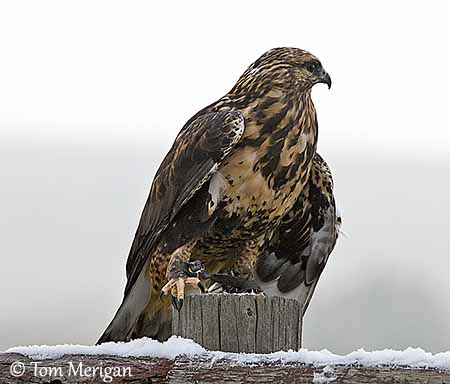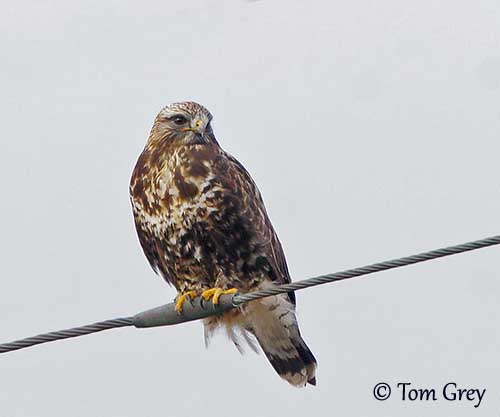
Fr: Buse pattue
Ang: Rough-legged Buzzard – Rough-legged Hawk
All: Raufußbussard
Esp: Busardo Calzado
Ita: Poiana calzata
Nd: Ruigpootbuizerd
Sd: Fjällvråk
Photographers:
Tom Grey
Tom Grey's Bird Pictures
Tom Merigan
Tom Merigan’s Photo Galleries
Bob Moul
Nature Photography
Otto Plantema
Trips around the world
Ingo Waschkies
Bird Photography
Text by Nicole Bouglouan
Sources:
HANDBOOK OF THE BIRDS OF THE WORLD Vol 2 by Josep del Hoyo-Andrew Elliot-Jordi Sargatal - Lynx Edicions - ISBN: 8487334156
HAWKS, EAGLES AND FALCONS OF NORTH AMERICA by Paul A. Johnsgard - Smithsonian Institution Press - ISBN: 1560989467
GUIDE DES RAPACES DIURNES – Europe, Afrique du Nord et Moyen-Orient de Benny Génsbol – Delachaux et Niestlé – ISBN : 2603013270
THE HANDBOOK OF BIRD IDENTIFICATION FOR EUROPE AND THE WESTERN PALEARCTIC by Mark Beaman, Steve Madge - C. Helm - ISBN: 0713639601
L’ENCYCLOPEDIE MONDIALE DES OISEAUX - Dr Christopher M. Perrins - BORDAS - ISBN: 2040185607
BirdLife International (BirdLife International)
Animal Diversity Web (University of Michigan Museum of Zoology)
All About Birds (Cornell Lab of Ornithology)
What Bird-The ultimate Bird Guide (Mitchell Waite)
Wikipedia, the free encyclopaedia
Rough-legged Buzzard or Hawk
Buteo lagopus
Accipitriformes Order – Accipitridae Family
INTRODUCTION:
The Rough-legged Buzzard is a member of genus Buteo including large, broad-winged buzzards and hawks with robust bodies. It occurs in the Northern Hemisphere, both in North America and Eurasia where it breeds. It migrates south during winter.
The name of this raptor comes from its feathered legs, well-adapted to the cold weather of its Arctic breeding grounds.
The plumage colour varies from dark to pale. Four subspecies are currently recognized and share the wide range.
DESCRIPTION OF THE BIRD:
Biometrics:
Length: 50-63 cm
Wingspan: 120-150 cm
Weight: M: 600-1370 g – F: 780-1660 g
The adult has variable plumage from dark to pale with some intermediate colours. But it always has some typical features such as the dark carpal patches, the dark trailing edge and the dark terminal tail band.
In light morph, the upperparts become darker towards the rump and the upperwing varies from dark brown to fuscous black. The flight feathers are barred.
The adult male has usually equally or more heavily marked breast than belly, and the tail shows several narrow dark bands between the base and the broad subterminal band.
The adult female has more heavily marked belly than breast. The tail shows the broad dark subterminal band with no or only one narrower band.
The uppertail-coverts are whitish and barred with fuscous-black. The tail is white except the dark bands.

The head is mostly paler, with buffy-white forehead and lores, whereas crown, cheeks, ear-coverts and nape are streaked dark, and are sometimes washed cinnamon-rufous. We can see a pale grey eyebrow.
The bill is black with yellowish-green to orange cere and gape. The eyes are hazel to dark brown. The toes are yellow with black claws.
The juvenile has paler head and pale grey eyes. The underparts are more heavily tinged buff to tawny. The belly is darker than in adults.
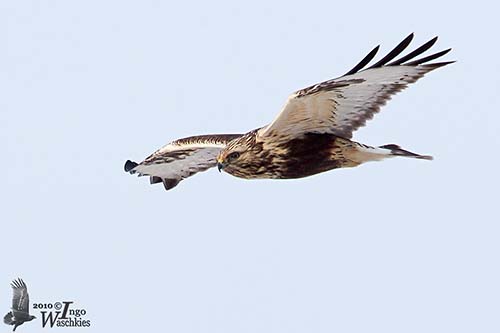
B.l. lagopus
Juvenile
In dark morph, the adult has fuscous-black to almost black general plumage. Crown and nape are usually streaked with whitish. On the wings, the secondaries are darker grey than in pale morph. The tail is dark brown with narrow whitish terminal band.
The juvenile is slightly more mottled with brown above and below than adults. Its eyes are brownish-grey to pale grey.

B.l. sanctijohannis
Dark morph
SUBSPECIES AND RANGE:
The Rough-legged Buzzard has four subspecies that differ mainly in size and intensity of pigmentation.
B.l. lagopus (here described) occurs in N Eurasia from Scandinavia, E to area of Ob and Yenisei Gulfs. It winters in C Europe E to C Asia.
B.l. menzbieri is found in NE Asia E of area of Ob and Yenisei Gulfs. It winters from C Asia E to China and Japan. This race has yellow eyes and is paler overall.
B.l. kamtschatkensis occurs on the shores of Sea of Okhotsk, Kamchatka and Kuril Islands. It probably winters in SE Russia, NE and E China and Japan. This race is fairly large and dark.
B.l. sanctijohannis is found in Alaska and N Canada. It winters in S Canada and most of USA. This is the smallest race and the dark morph is fairly common.
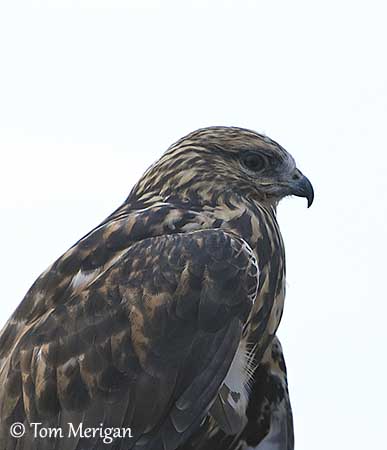
HABITAT:
The Rough-legged Buzzard breeds in treeline area in North America and Eurasia, around treeless taiga and tundra. It nests in trees along the fringe of the boreal forest. In the Arctic, it breeds on riverside cliffs and elevated sites or rocky escarpments.
During winter, it migrates southwards into open areas such as plains, prairies, steppes, coastal marshes, usually in open habitats with good long-distance visibility including harvested fields and pastures where it can hunt small rodents.
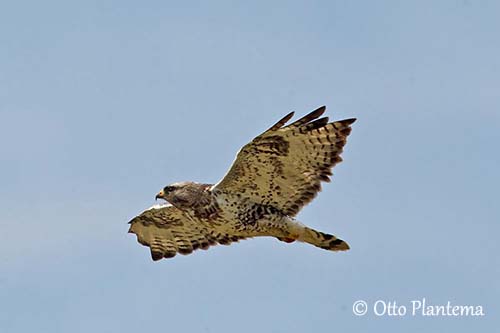
CALLS AND SONGS: SOUNDS BY XENO-CANTO
The Rough-legged Buzzard is usually silent, but on the breeding grounds, if the bird is threatened or disturbed near the nest, it gives a loud, mewing squeal “peeeeooo” or “pi-i-iee” of 1-5 seconds long and descending in pitch. This sound is more mournful, but also lower pitched than that of the Eurasian Buzzard. We can also hear a shorter scream given with a wavering voice.
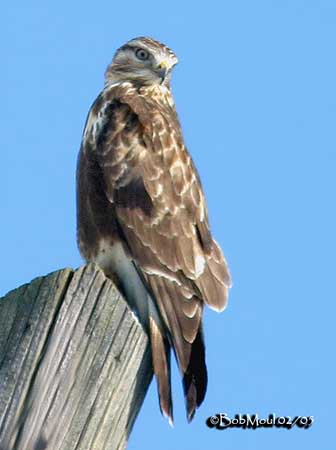
B.l. sanctijohannis
Juvenile (pale eyes)
BEHAVIOUR IN THE WILD:
The Rough-legged Buzzard feeds primarily on small mammals including mainly small rodents such as voles and lemmings, but also mice, hares, ground squirrels, weasels and even bats, and some small birds (mainly fledglings during the breeding season), from passerines to grouses and waterbirds. It also consumes fish, large insects (grasshoppers and crickets) and carrion (mainly in winter).
The Rough-legged Buzzard hunts from perches from where it waits for preys. But it also hunts in flight at about 10-15 metres high. It remains almost motionless while hovering during several seconds to detect a prey. Once detected, it dives gradually and catches the prey with the talons held forwards.
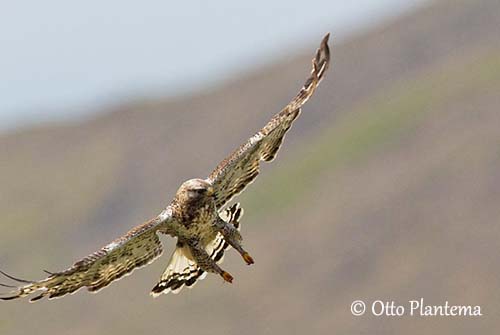
The Rough-legged Buzzard is monogamous with pair-bonds maintained at least during the breeding season. Competition for nesting-sites is hard with resident species such as Common Ravens, Gyrfalcons and Peregrine Falcons. But the buzzard often selects a cliff ledge, or if not available, a top of rock on steep slope.
The displays of this species are poorly known, but we can suggest that they are similar to those of the typical Buteo hawks. They perform spectacular aerial displays, both mates circling high in the sky while calling. The male may perform a “sky dance” with deeply undulating flight, stooping down and climbing back up and repeating these displays.
This behaviour often starts on the wintering grounds where the pair bond is usually formed.
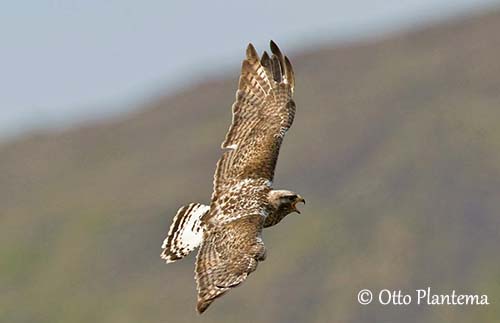
The Rough-legged Buzzard is migratory and moves southwards after breeding.
It frequently hovers while hunting in flight. Gliding and soaring are the usual flying behaviour. It performs powerful wingbeats interspersed with glides.
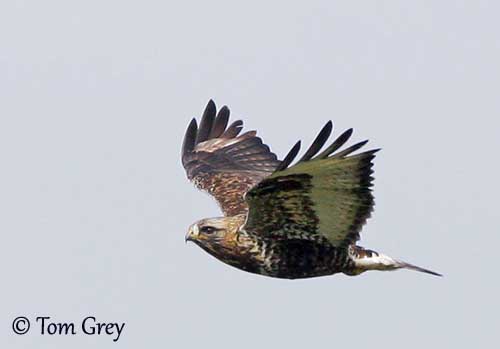
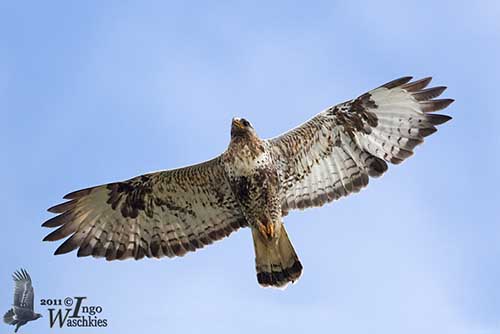
REPRODUCTION OF THIS SPECIES:
The breeding season takes place in spring, with the egg-laying in May-June, or occasionally in late April or early July according to the range.
The nest-site is selected by the male. It collects materials and the female builds the nest. This bulky structure is made with sticks and twigs, and lined with grass, hair and feathers. It is often sheltered by an overhanging rock. Several nests can be found in the same area and fairly close to each other. They are used in turn in several following years.
The clutch depends on food availability and may vary from 3-5 to 5-7 eggs, or only 2-3 in bad years. The incubation lasts 28-31 days, mainly by the female, but the male feeds her during this period.
At hatching, the chicks have first a grey down, but the second down is darker, mostly brownish-grey. They are fed by both adults and fledge between 34 and 45 days after hatching. They are independent about 3-5 weeks later. The young males fledge usually one week before the young females.
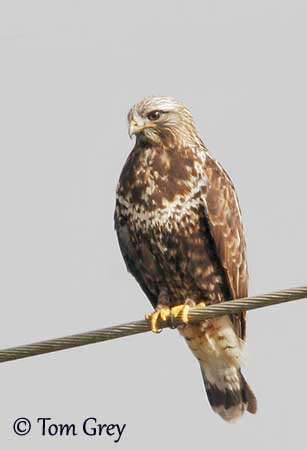
PROTECTION / THREATS / STATUS:
The Rough-legged Buzzard has wide range in which it is widespread. The species and its habitat are not subject to excessive human pressure and disturbance, except on the wintering grounds with hunting pressure and road traffic accidents.
The global population was estimated to number more than 500,000 individuals in 2004, and is suspected to be stable.
The Rough-legged Buzzard is currently evaluated as Least Concern.
